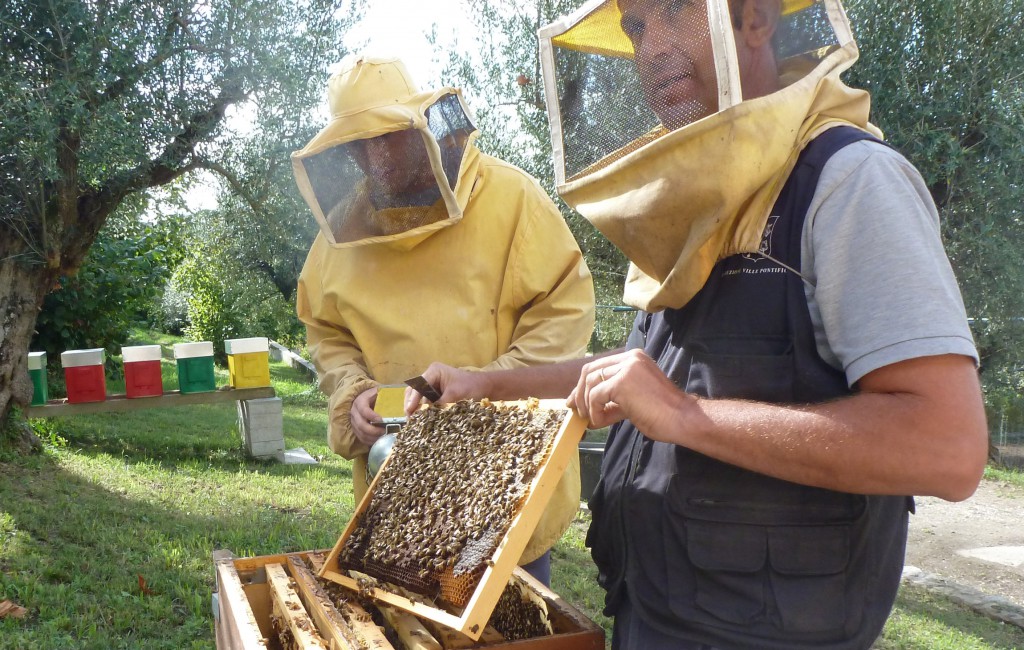
By Carol Glatz
Not a sound bounced off the smooth white walls and vaulted brick ceiling as a Vatican gardener hunched over a large, empty glass jar.
Two other men peered over his shoulder, waiting for the finished product to ooze slowly from the stainless steel spout.
As the thick, dark amber flow rippled into the container, Vincenzo Scaccioni, the head of agricultural operations at the pontifical villa of Castel Gandolfo, said: “This is a historic moment.”
It was historic because it was the year’s first honey harvest for the new pope by the little known, but very busy, papal bees.
And it was lucky because there had been a drastic dip in this year’s honey production.
“Maybe we’ll get three or four kilo (seven to eight pounds), not even,” said the Vatican beekeeper Marco Tullio Cicero, as he peeked into the stainless steel centrifuge that spun the honey from its golden honeycomb.
“As long as there’s a jar for him,” the pope, it will be enough, said Scaccioni. “It’s a limited edition,” he said with a smile.
Scaccioni oversees 26 employees who work on the villa’s 74 acres of gardens and 62 acres of farmland.
Pope Pius XI expanded the papal farm in 1930, Scaccioni said, in part to “express the universality and the fullness of the church and countryside,” and to make use of the fertile pastures — which had been abandoned after the loss of the Papal States in 1870 –to provide fresh fare for the papal menu.
The villa’s workers raise free-range chickens, rabbits, ducks, pheasants and other fowl for meat, calves for veal, cows to provide milk and milk products like mozzarella, cheese and yogurt, and hens for eggs.
They also harvest fruit and olive orchards and vineyards, cut hayfields, tend vegetable patches and grow flowers and plants that often are used to decorate the papal apartments and meeting rooms at the Vatican.
The aromatic herbs and flowering plants also provide an abundance of nectar for the bees, which work from dawn to dusk collecting the sweet water to turn into wildflower honey for the cold winter months.
What the pope and his closest aides do not use is sold to Vatican employees and retirees at the Vatican discount supermarket.
Scaccioni, who has a degree in agricultural science, was promoted in November from his role as botanist at the gardens inside Vatican City State, to heading the pontifical gardens and farm at Castel Gandolfo.
He said the papal farm is ready for an overhaul, and the first thing on his list is the bees, with an eye to expanding their presence and boosting their output.
The papal farm has always had bees, he said, but in recent years, they had been somewhat neglected. Also, extreme weather patterns over the past few years haven’t helped, as intense heat and unseasonal rains have cut their honey production in half.
More trouble in the mix was extensive swarming this spring. A swarm occurs when half of the hive’s occupants fly off to find a new, roomier home, resulting in smaller families with half the workforce and double the work. Starting from scratch, the bees spend the entire summer building new wax comb and storing reserves instead of just cranking out honey for the leader of the universal church.
While swarming hurt honey production this year, it also meant the bee yard doubled from eight hives to 16, positioning the papal bee business for future growth, Scaccioni said.
He said, “In about two or three years, we want to start being able to offer pollen, propolis and royal jelly,” all honeybee products that are considered to have nutritional, cosmetic or curative effects.
Helping the bees by increasing the number of hives and planting more nectar-producing plants is part of Scaccioni’s larger vision for better supporting the papal farm.
Bees are “very useful insects for agriculture,” he said, since flowers need to be pollinated for food to grow. Meat production, too, depends on hay and grains, which depend on pollination.
The role bees play in feeding the world is one that commands “deep respect,” he said.
In an era of intense, high-yield single crops dependent on petro-chemical pesticides and fertilizers, Scaccioni said, people are beginning to understand the importance of a more holistic, organic approach to agriculture that “benefits the plants, benefits nature” and the larger ecosystem.
Also, “bees are a symbol of industriousness, unity and a community that gives fruit,” he said. “It is an example that the church, deep down, is a hive, though not one that stings, but gives honey.”
Having a papal farm is still important today, Scaccioni said, because “it’s a real sign of the popes’ attention to creation, nature and the countryside.”
Popes John Paul II, Benedict XVI and Francis have all personally visited the farm to see the animals and watch how the milk is made, he said.
Like his predecessors, Pope Francis has called on people to be guardians of creation “in a world that’s increasingly harder to protect,” Scaccioni said.
“There are many global threats and this small sign — right in the heart of the church, at the Vatican — is more important than ever before.”
The papal beekeeper, Marco Tullio Cicero, who is named after an ancient Roman philosopher, offered his own reflection on the significance of his work.
“I have great admiration for the bees who, despite the problems they face” from the weather, pollution or disease, don’t give up, he said. “We need to value this lesson they teach us: always to press onward.” – CNS